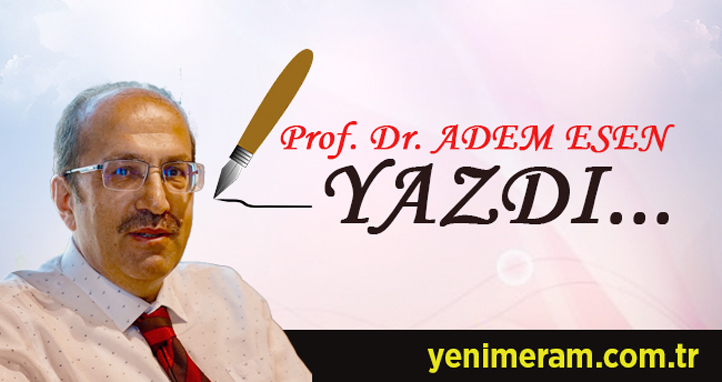Prof. Dr. Adem Esen
East Turkestan, with a land area two and a half times that of Turkey, possesses fertile land and valuable minerals, apart from the Taklamakan Desert – one of the world's largest deserts – which covers one-third of its territory. For this reason, it is called the "Land of Treasures." There are varying figures regarding its population, with estimates ranging up to thirty million.
The Han Chinese, who constituted only 6% of the population until 1953, made up 40% of the population by the year 2000, and constitute an even larger percentage now. Consequently, China's assimilation policies are ongoing in this region.
We learn about the events unfolding in East Turkestan, currently under Chinese administration, through various channels. One of these is the master's thesis written in Arabic by Mehmet Emin Uyguri at the University of Tripoli, Lebanon, titled "Sirāʿ al-Hawiyya al-Siyāsiyya fī Turkistān al-Sharqiyya: Taḥaddiyāt al-Wāqiʿ wa Āfāq al-Dawr" (Political Identity Conflict in East Turkestan: Current Challenges and Role Expectations). It has been published in Istanbul by İRA Akademi publications under the Turkish title "Doğu Türkistan’da Siyasi Kimlik Tartışması, Günümüz Durumu ve Rol Beklentileri" (Arabic, 184 pages).
Prof. Dr. Seyfeddin Abdülfettah, a faculty member in Political Science at Cairo University, who wrote a foreword (takriz) for the book, begins by stating that Muslims, wherever they are in the world, must "stand in solidarity with one another and not be divided." He states that the function of the Muslim world is not destruction but the development (imar) of the world, noting that in the Quran, Allah uses the term "wasat ummah" (a justly balanced community) for the Muslim community. Abdülfettah noted that the author of the book successfully addresses the political, social, cultural, educational, and economic problems personally experienced by himself and the Uyghur Turks, who have become a minority under Chinese rule since the 18th century. Although massacres, torture, and various injustices committed against Uyghur Turks-Muslims are reported in Western media, they do not find sufficient support from the Turkic world, the Islamic world, or other countries. But at the very least, such publications contribute to the aspect of moral solidarity, which is considered "the weakest form of faith."
The first part [of the book] discusses: China's pressures on the identity, religious institutions, families, and educational institutions of the Muslim Turkic-Uyghur presence; the suppression of scholars (ulama) and intellectuals; factors threatening the security of the society; and examples of massacres and persecutions carried out under the pretext of counter-terrorism. The second part outlines the political associations (musharakah) and armed organizations of Muslim Uyghurs. It mentions organizations within the Xinjiang region and those in Muslim countries outside Xinjiang. In this context, the activities of the World Uyghur Congress and the Turkistan Islamic Party in Syria are mentioned.
Historically, East Turkestan has never belonged to China. The region was historically home to Persians and adherents of earlier Turkic beliefs before Islam became established, and a significant Islamic civilization flourished there. Islam came to the region, whose roots trace back to the Hunnic Turks, during the Abbasid period. Satuk Bughra Khan, the ruler of the Karakhanid state founded by Uyghur Turks, accepted Islam in the 10th century, making it the first Muslim state in Turkic history. Works central to Turkic culture, such as Mahmud Kashgari's Dīwān Lughāt al-Turk and Yusuf Khass Hajib's Kutadgu Bilig, were written in this region.
From the mid-eighteenth century onwards, influenced partly by internal conflicts among the Uyghur Turks and with British support, China's influence in the region grew, and China annexed the region in 1757. From this period onwards, cities began to be plundered, and the Turks started being impoverished and reduced to a minority status. With the establishment of the Kashgar Khanate in 1864, during the reign of Sultan Abdülaziz, they officially attached themselves to the Ottoman state, delivered the Friday sermon (khutbah) in the name of the Ottoman Caliph-Sultan, and minted coins in his name. While relations with the Ottomans were developing, they were severed by the '93 War' (the 1877-1878 Russo-Turkish War). In 1884, China declared it the 19th province and gave it the name Sinkiang (Xinjiang in modern pinyin, Sincan in Turkish), meaning "New Frontier." However, the struggle of the Uyghur Turks did not end; in 1933, they established the East Turkestan Islamic Republic. Later, after the recurring uprising in 1944, they established a republic again, but in 1949, the Chinese communists occupied the region, and as a result of cooperation between Stalin and Mao, the dark days of East Turkestan began once more.
The people of East Turkestan never severed their ties with Anatolia; they provided financial support during the Balkan Wars and made their Hajj pilgrimages via Istanbul. (See: Union of Turkish World Municipalities, Doğu Türkistan in Ottoman Documents. Istanbul, 2016). Russia also had claims on the western part of East Turkestan at certain times. Therefore, the region has been an area of contention between China and Russia. While the countries in West Turkestan gained independence after the dissolution of the Soviet Union, East Turkestan under Chinese rule faces a great threat.
The struggle of the people in East Turkestan is to preserve their Muslim and Turkic identity. The Chinese communist administration, however, engages in all kinds of activities destructive to this identity, carrying out mass executions and imprisonments, impoverishing the population, and portraying those who do not obey them to the world as terrorists. The Chinese administration is displacing the people from their homeland. Through local authorities and the 'agricultural army' (Xinjiang Production and Construction Corps - XPCC), it implements policies aimed at completely assimilating the Uyghur-Turkic people. It imposes its own interpretation of Islam and forces youth and children into education aligned with its ideologies. Perhaps unimaginable practices exemplify this: under the guise of the "Pair Up and Become Family" program, a Han Chinese cadre is placed in a Uyghur family, undermining all the family's values, and threatening them with exile or imprisonment if they refuse.
5 May 2025

